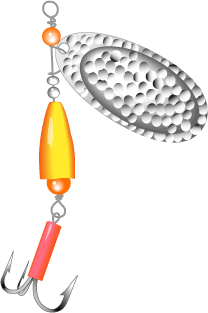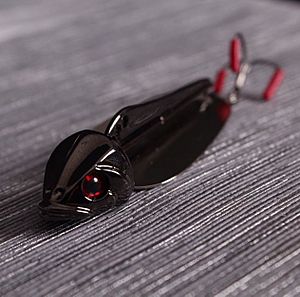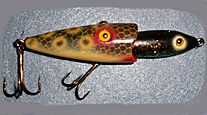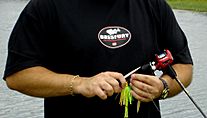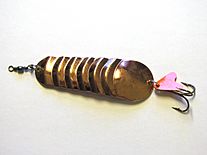Fishing lure facts for kids
A fishing lure is an object used to catch fish. It is tied to the end of a fishing line. A fishing lure is made to look like something a fish would eat. They move in a special way and have certain colors. Lures have fishing hooks attached to them.
They are usually used with a fishing rod. When a lure is used, it is cast, or thrown, out into the water and pulled back in. A good fisherman can cast the lure into places where the fish hide, like under logs.
There are many types of fishing lures. Most of them are made to look like dying, injured, or fast fish. They can be made of wood, plastic, rubber, metal, cork, feathers, animal hair, and other things. Some are shiny so that they catch the fish's attention.
Fishing lures can come in many different types such as a jig or a popper. A jig will usually have a weight attached to it so it can float at the right height. A popper is a lure used to attract trout and bass. A popper has a colorful design in the front to attract fish. Fishing lures can be very expensive as some are sold for thousands of dollars.
The fishing lure was invented in 1890 by a man named James Heddon. He created the fishing lure by accident by taking a big piece of wood and carving a frog shape into it and taking the lure and attaching it to his line. Then he threw it in the water and immediately caught a bass. The next day he started a company called the Heddon Company and the era of the fishing lure was born.
Types
There are many types of fishing lures. In most cases they are manufactured to resemble prey for the fish, but they are sometimes engineered to appeal to a fishes' sense of territory, curiosity or aggression. Most lures are made to look like dying, injured, or fast moving fish. They include the following types:
- A jig is a weighted hook with a lead head opposite the sharp tip. They usually have a minnow or crawfish or even a plastic worm on it to get the fish's attention. Deep water jigs used in saltwater fishing consist of a large metallic weight, which gives the impression of the body of the bait fish, which has a hook attached via a short length of kevlar usually to the top of the jig. Some jigs can be fished in water depths down to 300 metres.
- Surface lures are also known as top water lures, poppers and stickbaits. They float and look like fish prey that is on top of the water. They can make a popping, burbling, or even a buzzing sound. It takes a long time to learn how to use this lure effectively
- Spoon lures usually look like a spoon, with a wide rounded end and a narrower pointed end, similar n shape to a concave spearhead. They flash in the light while wobbling and darting due to their shape, which attracts fish.
- LED lures have a built in led and battery to attract fish. They use a flashing or sometimes strobing pattern, using a combination of colors and leds.
- Plugs are also known as crankbaits or minnows. These lures look like fish and they are run through the water where they can move in different ways because of instability due to the bib at the front under the head.
- Artificial flies are designed to resemble all manner of fish prey and are used with a fly rod and reel in fly fishing.
- Soft plastic baits are lures made of plastic or rubber designed to look like fish, crabs, squid, worms, lizards, frogs, leeches and other creatures.
- Spinnerbait are pieces of wire that are bent at about a 60 degree angle with a hook at the bottom and a flashy spinner at the top.
- Swimbait is a soft plastic bait/lure that resembles an actual bait fish. Some of these have a tail that makes the lure/bait look like it is swimming when drawn through the water.
- Fish decoy is a type of lure that traditionally was carved to resemble a fish, frog, small rodent, or an insect that lures in fish so they can be speared. They are often used through the ice by fishermen and also by the Inuit people as part of their diet. The Mitchell Museum of the American Indian collection includes Native American fish decoys. William Jesse Ramey is considered a vintage master carver of fish decoys, and his work has been featured in museums.
- Combined lures combine properties of several different types of lures.
Fishing lures can be made of wood, plastic, rubber, metal, cork, and materials like feathers, animal hair, string, tinsel and others. They can have many moving parts or no moving parts. They can be retrieved fast or slow. Some of the lures can be used by alone, or with another lure.
One advantage of use of artificial lures is a reduction in use of bait. This contributes to resolving one of the marine environment's more pressing problems; the undermining of marine food webs by overharvesting "bait" species which tend to occur lower in the food chain. Another advantage of lures is that their use promotes improved survival of fish during catch and release fishing. This is because lures reduce the incidence of deep hooking which has been correlated to fish mortality in many studies.


